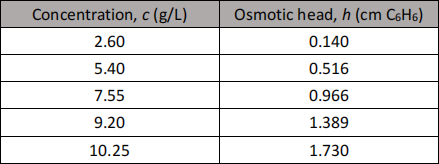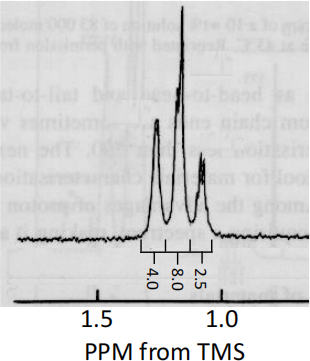CHMS 5120 – Materials Analysis (Polymer Analysis) Assignment 2
Hello, dear friend, you can consult us at any time if you have any questions, add WeChat: daixieit
Department of Chemistry
CHMS 5120 – Materials Analysis (Polymer Analysis)
Assignment 2
1. A polystyrene sample was dissolved in benzene (C6H6) to obtain solutions of different known concentrations. Measurement of osmotic head for these solutions at 30 oC with a static equilibrium osmometer produced the following data:

[Given: density of C6H6 (30oC) = 0.868 g cm-3 ; density of polymer (30 oC) = 1.055 g cm-3 ]
Determine for the polymer:
a) Mn
b) The second virial coefficient (A2).
c) The Flory-Huggins polymer-solvent interaction parameter (χvalue) of this polymer in benzene.
2. Consider the structure of the chloroprene monomer:

a) Sketch all the possible constitutional isomers of polychloroprene.
b) Which constitutional isomers is/are expected to show elastic behavior. Briefly explain your choice.
3. The structure of poly(α-methyl styrene) is shown below:

a) Sketch the isotactic, syndiotactic, and heterotactic triads of poly(α-methyl styrene).
b) Polymer with which configuration(s) is/are expected to show the greatest crystallinity? Briefly explain your answer.
c) The partial 1H-NMR spectrum below shows the resonance peaks of the α-methyl protons in a sample of poly(α-methyl styrene). Assign the peaks to the configurational triads. [3 points]

d) Based on the 1H-NMR spectrum, calculate the percentage of the polymers in the three configurations.
4. A sample of a semi-crystalline thermoplastic has been analyzed by differential scanning calorimetry (DSC). The heat flow rate upon a heating up and cooling down cycle is measured to obtain the DSC plot below.

a) In the DSC plot, what does “endo” and “exo” mean? Is it relative to the polymer sample or relative to the DSC instrument?
b) Label the Tg, Tc and Tm on the DSC plot.
c) Estimate the values of Tg, Tc and Tm.
d) Describe what is happening to the polymer chains during each of these thermal transitions.
2024-04-06